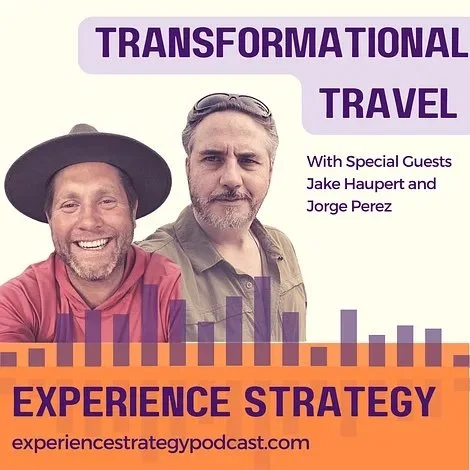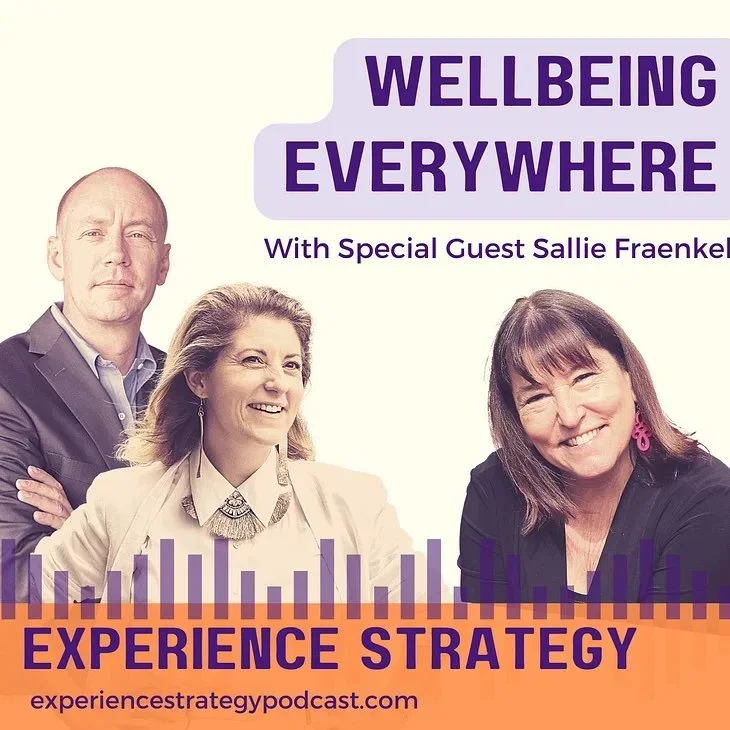Stone Mantel Experience Strategy Blog
Market Research Technique: Conjoint Analysis
There are a variety of qualitative and quantitative research tools that can be used to help businesses understand how best to design and optimize the experiences they are delivering to their customers for customer value and time well spent. Today we will dive into one of our favorite quantitative methods - conjoint analysis.
Experience Strategy Podcast: Why you need a strategic POV on your CX
On today’s episode of Experience Strategy Podcast, hosts Dave Norton and Aransas Savas will prove to you that your business needs a strong strategic POV on your customer experience in order to thrive. Listen in to hear how brands like @Apple, @W Hotels, and @Best Buy’s Geek Squad used a compelling experience POV to innovate and drive business success.
Experience Strategy Podcast: Transformational Travel
Today we are joined by Jake Haupert and Jorge Perez, thought leaders and entrepreneurs in transformational travel. We explore why travel is the perfect launchpad for the transformation economy; how transformational experiences differ from our traditional ways of looking at categories like healthcare, finance, retail, technology and beyond; which customer types seek transformation and why they value it. Most importantly, we talk about how to effectively deliver on transformation.
Key Experience Strategy Trends for 2023, Trend 6: Context is King
Content is no longer king. Context is. As the attention recession deepens, effective experience strategies will increasingly be driven by technology, time, and situation.
Key Experience Strategy Trends for 2023, Trend 5: Hybrid is Here to Stay
Hybrid is here to stay. Church, school, shopping, concerts, and theater are all hybrid for good. IRL alone will continue to wane.
Key Experience Strategy Trends for 2023, Trend 4: Uncertainty is Certain
Now that we’ve proved how adaptable we are, customers will increasingly expect agility. Experience strategists will need to rethink customer journeys and experiences to deliver just-in-time products and services despite outages and political instability.
Experience Strategy Podcast: Wellbeing Everywhere with Sallie Fraenkel
Historically, customers expected categories like hospitality and healthcare to support their wellbeing. Today, categories as wide-ranging as finance and electronics are expected to design for wellbeing. Don’t think you’re in the wellbeing industry? Think again. Cultural shifts and crises have changed the game. In this episode, we are joined by Sallie Fraenkel, the founder of Mind Body Spirit Network, and the former CMO & COO of SpaFinder and EVP for the Global Wellness Summit. Together we look at how changing customer expectations influence the perception of your experience and specific ways that you can meaningfully integrate wellbeing for your customers and company.
Key Experience Strategy Trends for 2023, Trend 3: Zoom in on Small Groups
Historically companies have focused on the segment (the big picture) or on individuals (personalization), but the opportunity is the small group: families, friends, working connections, suppliers, and personal connections.
Key Experience Strategy Trends for 2023, Trend 2: Powered by Customer Purpose
Having a company purpose does not equate to understanding your customer's purpose. With savvier customers, and increased demand for transparency on all fronts, companies that focus on their purpose story will struggle, but those that focus their experience on their customers' purpose will thrive and foster sustainable engagement.
Key Experience Strategy Trends for 2023, Trend 1: Wellbeing Everywhere
Customer needs and expectations are always evolving. What can recent trends in those needs and expectations tell you about what’s coming next? And how can you optimize your experience roadmap and prepare your business for what’s next? These are the big questions we answer in our first annual Experience Strategy Trends Report.
Big news! 🎉 We are thrilled to announce the first-ever Experience Strategy Trend Report
After almost 20 years on the cutting edge of Customer and Employee Experience trends, we are thrilled to announce the first-ever Experience Strategy Trend Report coming your way in January 2023!
What is Experience Strategy
In 2002, when many companies started realizing the power of ‘experiences’ to create value, Joe Pine used Peter Drucker’s famous line to describe the aim of Experience Strategy. First, here’s Peter Drucker’s declaration:
But the aim of marketing is to make selling superfluous. The aim of marketing is to know and understand the customer so well that the product or service fits him and sells itself." (Management 1973)
At the time many of the ‘chief marketing officers’ were in fact salespeople who had been promoted. Drucker was frustrated with companies who thought they were doing marketing but had only retitled their sales function and he wanted to describe the distinction.
Case Study: Helping Southern Company Gas Become A More Future-Forward, Customer-Centric Company
The Southern Company Gas Customer Experience Team partnered across their organization to undertake experience research that would help them understand exactly what it would take to lift overall customer satisfaction as well as help the organization hear directly from their customers.
How to Deliver on Meaningful Experiences and Why They Matter for Customers, Brands, and Employees
We started studying meaningful experiences in the summer of 2018 in a world that looked and felt much different from today. We decided to study meaningful experiences because customer expectations were evolving rapidly. Spurred by new, smart experiences embedded into every aspect of their lives, people were no longer satisfied with experiences that lacked intelligence, meaning, or both. Companies were (and still are) getting better and better at creating content, products, and experiences. This abundance of experiences overwhelms people leading to a reduction in the net value of any one experience and the value of experiences generally.
Case Study: O’Charley’s Uncovering Deep Emotional Insights Through 360 Degree Ethnography
O’Charley’s, a 50-year-old casual-dining chain, offers comfort food with a Southern accent in a homey, welcoming atmosphere. However, as the casual dining category became more competitive and their guest’s expectations evolved, O’Charley’s lost market share and sales. They needed to outline a path to restore market share and increase sales by identifying the most important current and future customer jobs-to-be-done that would revitalize the brand and create new value.
Defining Jobs to be Done: Why Companies often fail at needs-based innovations
Customers have strong, if often unconscious, expectations of solutions they hire to help them. Experience strategists who understand the archetypes of jobs-based experiences are more likely to create value for the customer and the company.
What is “Jobs-to-be-Done?”
Jobs to be done is a strategic discipline that focuses on creating value for customers by understanding what customers want to in a given situation. The term was popularized by Clayton Christensen, the top innovation professor at Harvard in the 2000s and 2010s. His definition of what a ‘job to be done’ is:
“Job” is shorthand for what an individual really seeks to accomplish in a given circumstance. But this goal usually involves more than just a straightforward task; consider the experience a person is trying to create. The circumstances are more important than customer characteristics, product attributes, new technologies, or trends.
Defining CX Metrics: The Difference between NPS and TWS
Customer experience metrics are incredibly important to companies today. They are the first indicators of whether or not customers actually value what you are offering. The category giant, Net Promoter Score, has come under scrutiny by companies, academics, and especially customers. TWS metric is a new approach to CX metrics that can give you better indicators for how to improve your experience.
Time Well Spent: How People Evaluate Experiences
Companies evaluate customers' experiences in ways that are very different from how people do.
I’m going to say something about the experiences customers have with your company that, at first glance, is going to be so obvious to you that you may decide not to finish this article. But I’m then going to show you the implications of that observation and if you are honest with yourself you will realize that your company has not focused on the most obvious attribute of meaningful experience creation.
We live in a world of abundance. People have so many options before them, almost all instantaneously accessible. But, what no one has more of is time. Time is the limiting factor in what we can consume, enjoy, build, and even become.
People have always valued meaningful experiences. And with limited time and an abundance of experiences to choose from, the time we spend with experiences becomes even more valuable.
Case Study: Flagler Health+ The Transformational Impact of The Collaboratives on Healthcare Digital Thinking
In today’s world, providing a streamlined and positive experience is not only preferred by patients, but expected. When someone checks into a hospital or physician office, seeking help for a chronic or acute condition, there are feelings of stress, anxiety, uncertainty, and fear. These feelings are not only felt by the patient but also by friends and family and others in their circle of care. Many companies are working to use experience design methodologies to alleviate these feelings and improve overall patient outcomes. One company in particular, Flagler Health+, which includes an award winning 335- bed hospital that has a 130-year legacy of caring for the St. Augustine community, joined the Digital Healthcare Collaborative to do just that— take friction out of the patient experience through ideation and co-creation research.
It limits our business and alienates our audience: Why to drop the term “consumer” and what to use instead
“Consumer.” We see it all the time in business strategy, but the truth is, “consumer” only applies to commodities. The word misses the point for most companies in two major ways. First, it’s company-centric. It implies that consumers will consume what the company creates; people will use up an offering and, ideally, consume it again. Here’s an example of how limiting the term is: In the greeting card industry, people don’t consume greeting cards, they give them. They are givers. If strategists at a card company talked about their customers as “givers,” a rich array of givers’ attributes would come to mind; they’d explore what it means to give and how the company can support the experience of giving. By contrast, sticking with the word “consumer” keeps the focus narrowly on the attributes of the cards to be consumed.





















